Biohabitats Projects, Places, and People
By Quinn Caralle
Projects
Protecting Globally Rare Ecosystems
Pop quiz: Where in Ohio can you find the state’s only native cactus, the Eastern Prickly Pear (Opuntia cespitosa)? If you’re surprised to learn that Ohio is home to a native cactus, you’re probably not alone. This spiky species can be found flourishing in the sandy soil of the Oak Openings.
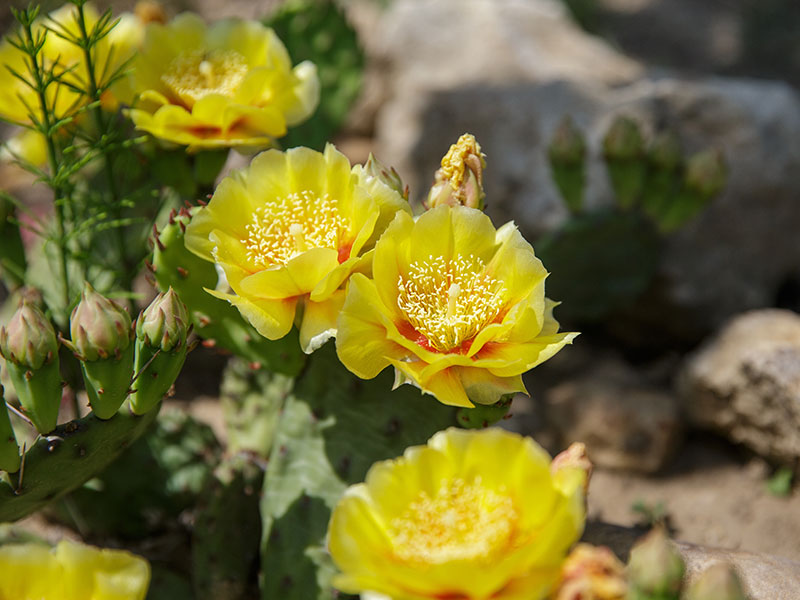
Deemed one of “America’s Last Great Places” by The Nature Conservancy (TNC), the Oak Openings ecoregion is one of Earth’s rarest, most distinctive habitats. The narrow stretch of sandy soil, tallgrass prairie, and widely spaced oak trees that make up the open woodland of the Oak Openings spans 80 miles through parts of Michigan and Ohio. Before agriculture and urban expansion reshaped the region, expansive oak savannas and wet prairies thrived in the Oak Openings’ dunes and unique sandy soil: a perfect environment for tall prairie grass and sprawling oak trees.
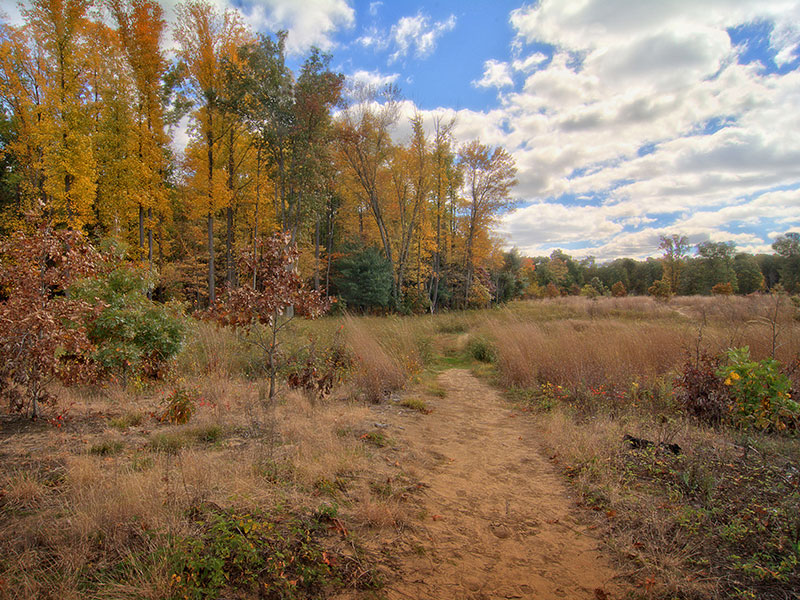
Since the 1950s, farmers in Ohio and across the United States have been excavating agricultural ditches to improve drainage from farm fields; removing rocky and woody habitats they viewed as obstacles slowing and impeding drainage flow, rather than natural assets. Larger, open channels were thought to be more efficient. This practice rerouted and reduced the amount of water that flowed through the Oak Opening’s wetlands, making conditions too dry to support the region’s unique wetland vegetation, local waterfowl, and other aquatic species. Well-intentioned fire suppression compounded this loss, quashing the burns that once maintained the spacious habitat by controlling the growth of shrubs and trees. Without water and fire, denser oak forests engulfed the savannas, creating too much shade for the rare plants and animals in the Oak Openings and worsening the decline in native biodiversity. Today, hundreds of rare and endangered species can be found in the region, including almost one-third of Ohio’s endangered plant species. Several endangered species of butterfly, including the federally endangered Karner (Lycaeides melissa samuelis), rely on protected patches of Wild Blue Lupine found in conservation areas in the Oak Openings.
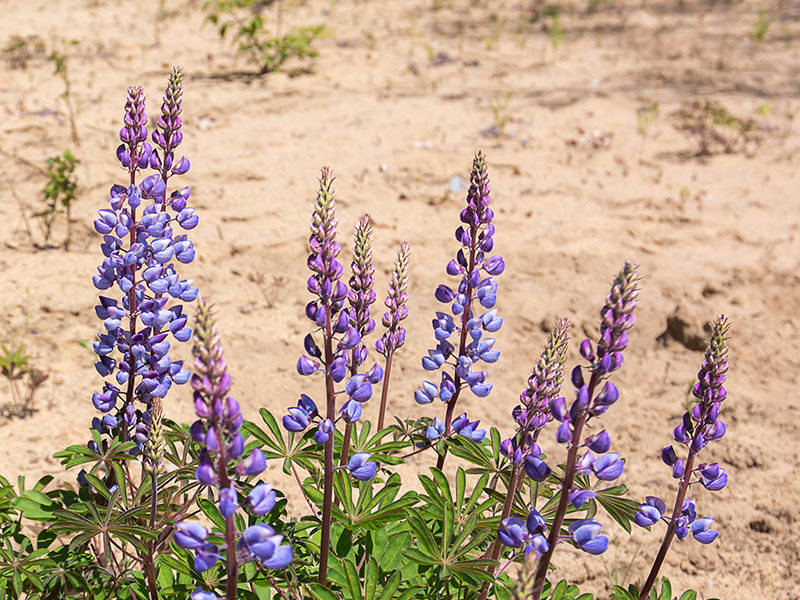
In the decades since human intervention altered the Oak Openings, natural area agencies and environmental organizations have been working to thoughtfully manage the region and reintroduce lost ecological function. The Green Ribbon Initiative, a group of public and private organizations and individuals working together to restore and protect the region in both Ohio and Michigan, has been dedicated to preserving contiguous corridors of Oak Openings habitat since 2000. Thanks to the Great Lakes Restoration Initiative (GLRI) and H2Ohio funding, restoration practitioners have a rare opportunity to help restore this precious ecosystem and provide significant ecological uplift while improving the Lake Erie watershed. Biohabitats is grateful that these grant opportunities are available, and that we can help reclaim pieces of the Oak Openings through our ongoing work with some of Ohio’s most dedicated ecological stewards.
As part of The Nature Conservancy’s (TNC) Natural Infrastructure Program, which restores wetlands and riparian areas across Ohio, Biohabitats and design-build partners Meadville Land Service (MLS) are restoring 2,500 LF of Blue Creek in the Maumee State Forest, located within the Oak Openings. Like many streams in the watershed, Blue Creek was straightened and converted into an agricultural ditch that has suffered decades of erosion and dredging. The project site harbors several rare species after being seeded (by the Ohio Department of Natural Resources and TNC) with local seed sourced from rare plants found in Oak Openings Preserve, a 4,180- public park and nature preserve in Swanton, Ohio. A plant survey is coming up in May 2024, with construction expected in the summer or fall of 2024. Once completed, the restoration will improve fish habitat, stabilize slopes, increase riparian and instream cover, and capture runoff through improved hydrology on site. The restoration design is specifically tailored to the project’s goals of improving habitat for fish and benthos, reducing stream maintenance needs, and improving aesthetics.
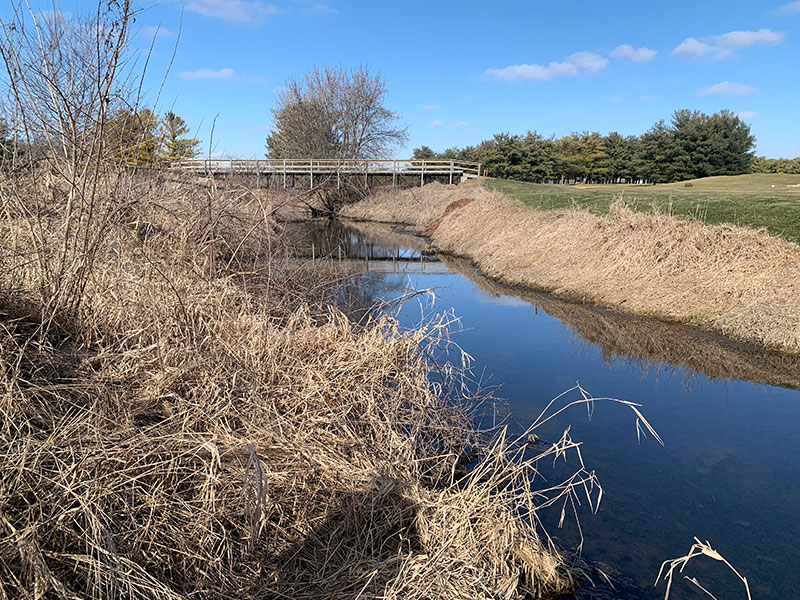
Biohabitats is also collaborating with MLS on the Blue Creek and Neis Ditch Stream Restoration Projects, both design-build efforts for Metroparks Toledo. Located in Oak Openings Preserve, the project sites in the Lower Blue Creek watershed faced years of damage due to agricultural ditching and development just like the reach of Blue Creek within Maumee State Forest. The project team is developing full design and construction plans to restore aquatic habitat for fish and benthos, stabilize the eroding streambank, improve instream habitat using root wads and live branch layering, enhance three acres of riparian habitat, and expand the floodplain; which will increase capacity during high flow events and improve hydrology and water quality via sediment and nutrient load reduction. This project is currently in the 60% design phase, with construction planned for fall 2024.

Both projects are funded by GLRI and will restore streams that were converted into incised agricultural ditches to address the grants’ main goal of restoring fish and benthos habitat, addressing the Maumee Area of Concern Loss of Fish and Wildlife Habitat Beneficial Use Impairment. An ecologically functional Oak Openings is key to the health of the people, plants, and animals that live there, as well as the waters of both the Maumee River and Lake Erie.

When Senior Restoration Ecologist and Project Manager Rachel Spadafore was asked what her favorite thing about the Oak Openings is, she answered, “In the vast sea of agriculture that is Northwest Ohio, the Oak Openings feels like a secret oasis, teeming with life. Cross a field and a ditch, and you may suddenly find yourself on protected land that harbors large numbers of rare plants and animals specifically adapted to the oak savannahs and sand dunes. It is a refreshing change of scenery.”
For more information about these projects, please contact Rachel Spadafore.
Let it flow, let it flow!
After the second phase of the Balm Grove Dam Removal wrapped up in 2023, this project to restore free flow and fish passage to Gales Creek is now complete. For decades, a 30-foot thick, 100-foot-wide concrete dam blocked fish passage, impeding access to miles of prime habitat for juvenile and adult mountain whitefish (Prosopium williamsoni), mountain sucker (Catostomus platyrhynchus), largescale sucker (Catostomus macrocheilus), coho salmon (Oncorhynchus kisutch), and the endangered Pacific lamprey (Entosphenus tridentatus) and winter steelhead (Oncorhynchus mykiss). The dam’s removal in September 2022 cleared the way for these species for the first time since the 1930s, and as soon as it was removed, the construction crew saw salmon successfully swim upstream. Instant gratification is rare for an ecological restoration project, and watching the creek and the fish that call it home respond so quickly and positively was a major moment for the project team brought together by Clean Water Services (CWS).
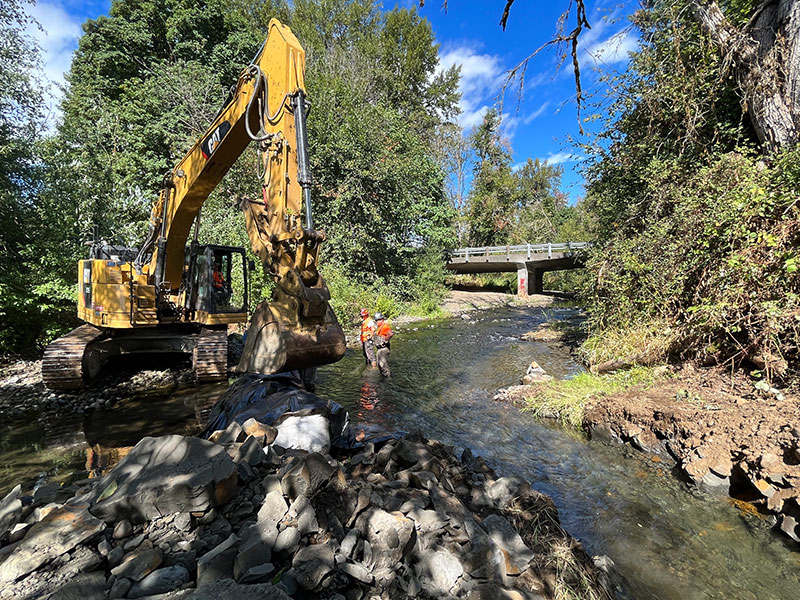
The second phase of the project focused on further improving habitat complexity, water quality, and sediment control along Gales Creek. Working against the clock during a short in-water work window, crews excavated a diversion channel, dewatered the main reach of the creek, salvaged fish and amphibians, built four large wood log structures, and excavated an earthen berm along the bank to allow the creek better connection with the floodplain. To complete the excavation, more than 1,000 LF of Gales Creek was dewatered and fished over two days. This spring, Biohabitats will help CWS revegetate the site by planting native vegetation, including 15,000 native shrubs and 1,000 live willow stakes.
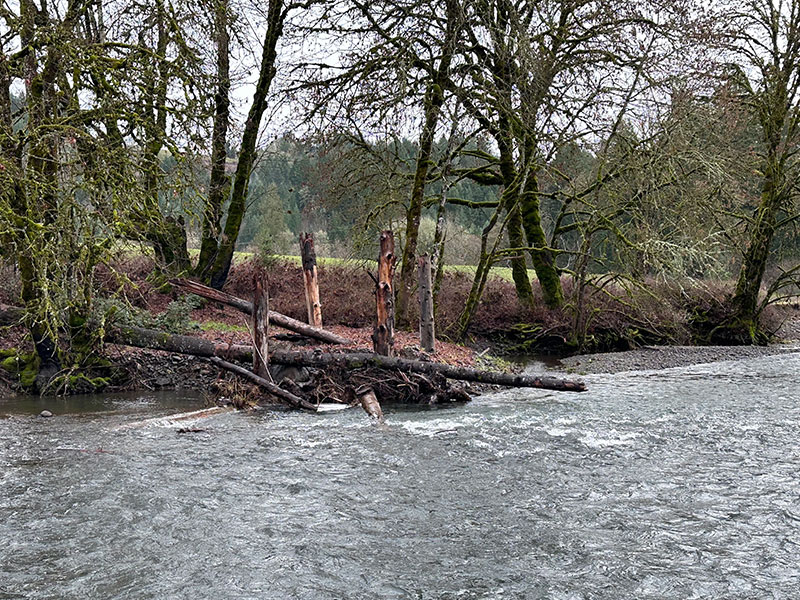
CWS dedicated years of work to the long-held community goal of removing Balm Grove Dam, and we were honored to join their team and provide ecological uplift to such a critical stream system. Native fish species can now swim upstream and use miles of habitat that were inaccessible for decades; a big step forward for the wildlife of Gales Creek and the Tualatin River basin and the larger statewide effort to restore habitat for federally listed endangered species. For questions about this project, please contact Matt Koozer.
Denver Adventures
In January 2023, we celebrated the groundbreaking of the Denver Museum of Nature & Science’s Nature Play experience, and we’re happy to say that construction on this exciting, interactive play experience is nearly complete! It won’t be long until visitors can explore the eight unique Colorado ecosystems exhibited in the Museum’s immersive outdoor installation in Denver City Park.
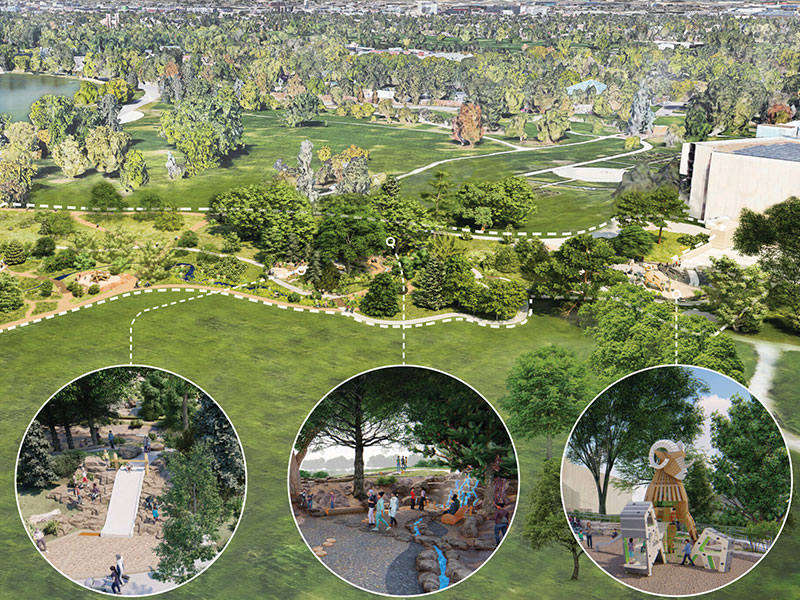
Working collaboratively with a team led by Dig Studio and integrating years of community input, Biohabitats provided analysis, ecological design concepts, restoration planning, and green infrastructure design support for Nature Play in City Park. Biohabitats planned natural features and habitat design elements along with the restoration of a historic waterway in the park in collaboration with Muller Engineers and the Dig Studio team. Visitors will be able to experience and enjoy the ecologically functional, flowing creek that winds though a box canyon, woodland, prairie grasslands, alpine tundra, and other play nodes full of native trees and plants. Among the tactile, educational features are a climbable 20-foot tall Rocky Mountain bighorn sheep, a climbable beaver dam, and three slides incorporated into the landscape. Each play area is ADA-accessible and inclusive for all visitors. Bienenstock Natural Playgrounds, an interdisciplinary team of designers, educators, and construction experts, was integral to the design and implementation of authentic, engaging play components for each area.
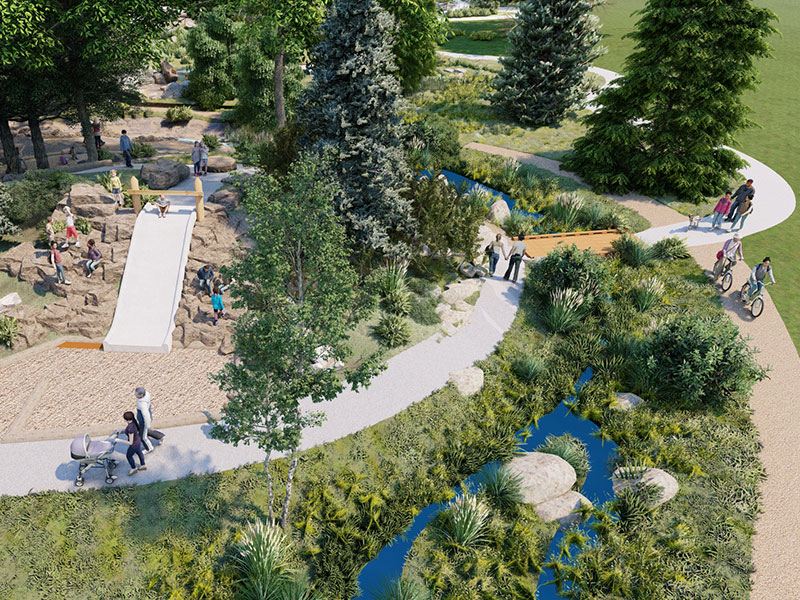
Other aspects of the Nature Play in City Park are its pedestrian-friendly focus; featuring bike racks that connect to the city’s biking infrastructure, benches carved from fallen trees found in city parks, and an educational pathway embedded with footprints of Colorado’s animals. We’re so excited to see visitors enjoying this ecological adventure, opening day can’t come soon enough! Learn more about the construction in this video from the Denver Museum of Nature and Science. If you have any questions about this project, please contact Claudia Browne.
Capital Investment in Design-Build
In Washington, DC, ecological restoration and conservation project teams are sometimes faced with unique sites that call for unique solutions. The neighborhoods of DC have changed over the years, and when construction unearths unexpected and unmapped infrastructure like pipes, building foundations, or abandoned housing connections, a variety of different District permitting offices must perform an inspection before a project can continue. Increased stormwater runoff from neighborhood development has led to eroded stream channels and impaired systems. Although this can challenge nature-based projects, design-build project delivery offers a streamlined workflow and clearer path of communication when dealing with an interesting project site.
A collaborative effort between the Anacostia Watershed Society and the District Department of Energy & Environment (DOEE), the RiverSmart Schools program is a schoolyard greening and conservation initiative that creates green space on school grounds to foster ecological awareness, improve aesthetics, and connect teachers and students with the Anacostia Watershed. Biohabitats is creating Low Impact Development stormwater features at three D.C. schools per year as part of a five-year design-build contract with the DOEE. Six of the fifteen projects have been constructed, and each boasts unique features that are tailored to the space and the needs of students.
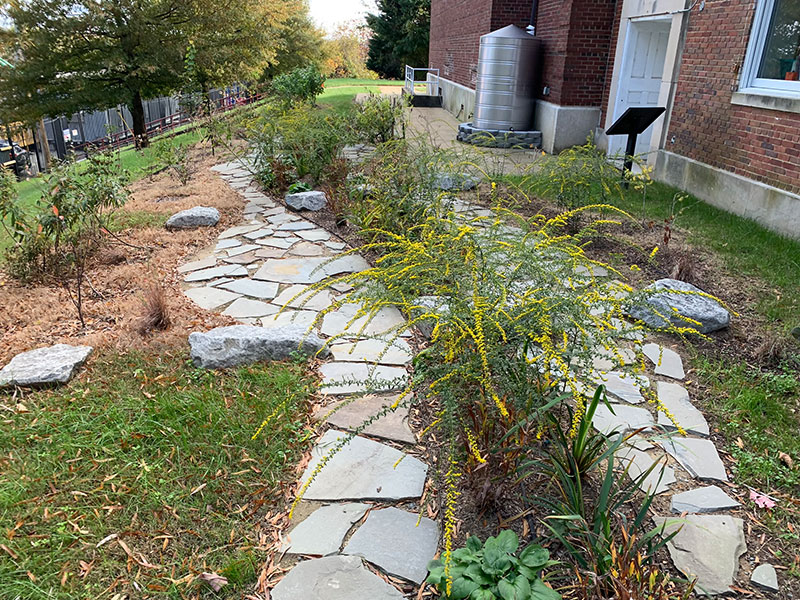
At Two Rivers Public Charter School and Lee Montessori, Biohabitats worked with contractors TCG Property Care to create innovative solutions for stormwater management features with limited space available. The front of Two Rivers’ building is in a historic viewshed that overlooks the Anacostia River. To avoid interfering with the view from the open space in front of the school, the project site was confined to a narrow area along the side of the building. With insufficient square footage for a bioretention BMP or submerged gravel wetland, Biohabitats designed a system that captures roof runoff into a 500-gallon cistern that irrigates an engaging, educational landscape and pollinator garden. The landscape features a pathway shaped like the Anacostia River that winds through native shrubs and herbaceous plants that grow low to the ground and are well-positioned for the reach the eyeline of students. Stepping stones that encourage students to cross the “river” lead to boulder seating that forms an open outdoor classroom.
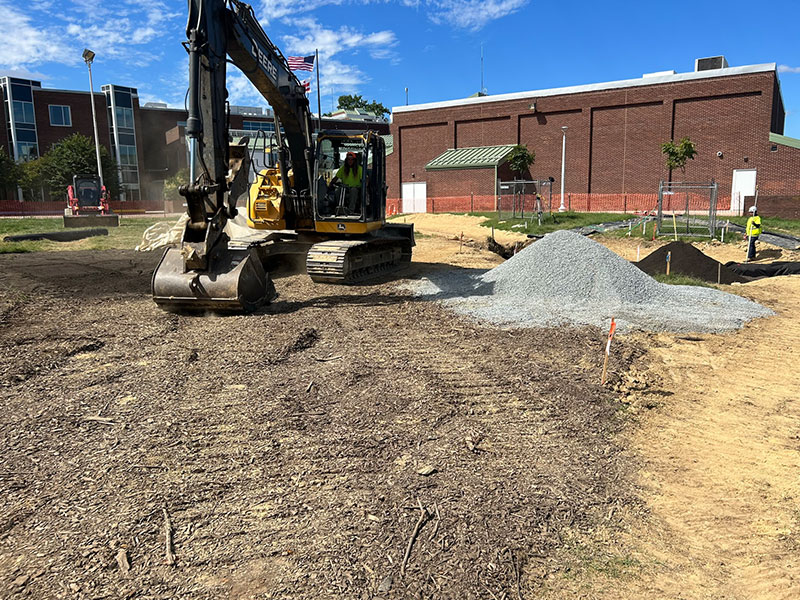
Biohabitats also worked with contractors Actaeon, LLC to implement low impact stormwater management facilities for Takoma Elementary, Anacostia High School, John Hayden Johnson Middle School, and Hendley Elementary School.
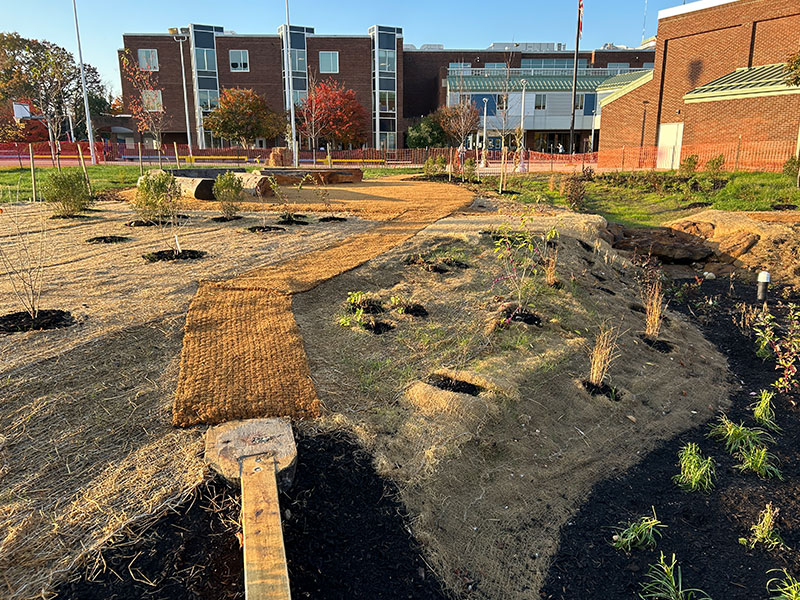
At Takoma Elementary, there was space for a more “elbows out” design. Takoma’s teachers are passionate about the educational potential of this green schoolyard, and their enthusiasm paved the way for an adventurous, hands-on experience for students. At this school, the bioretention area was designed to capture and treat more water given the available space. The project team created a bioretention garden surrounded by a trail and a Y-shaped wooden balance beam within the plantings that acts as a bioretention crossing. The trail connects to an outdoor classroom surrounded by native plants installed by student and teacher volunteers.
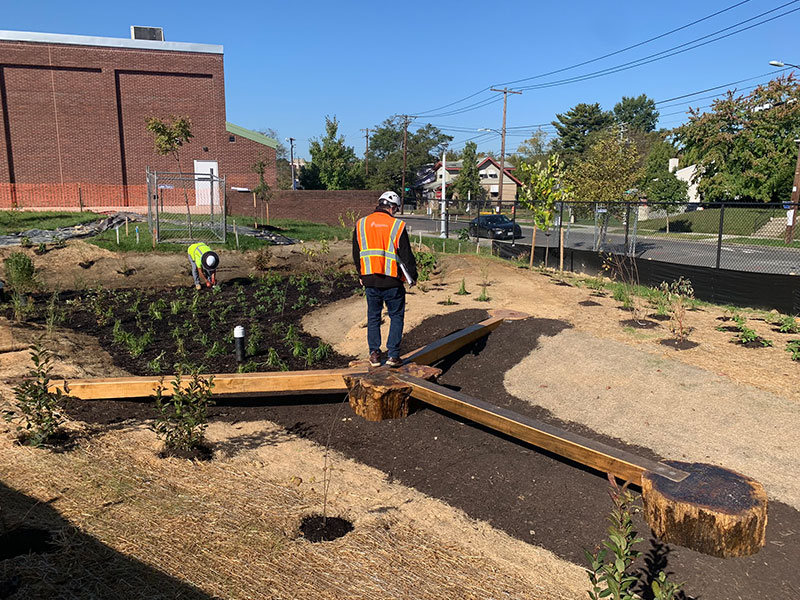
With the collective capacity to store 100 cubic yards of stormwater per rain event, the new stormwater features at these schools improve drainage, biodiversity, and outdoor experiences while also positively impacting water quality for the entire watershed. Please contact Bryan Arvai with any questions.
Nestled within the densely populated suburb of southeast D.C. lies Fort Davis Park, a rare piece of green space managed by the National Parks Service. The park is home to a vibrant forested area, with other portions of the park containing protected and preserved earthen Civil War fort, known as an earthwork.
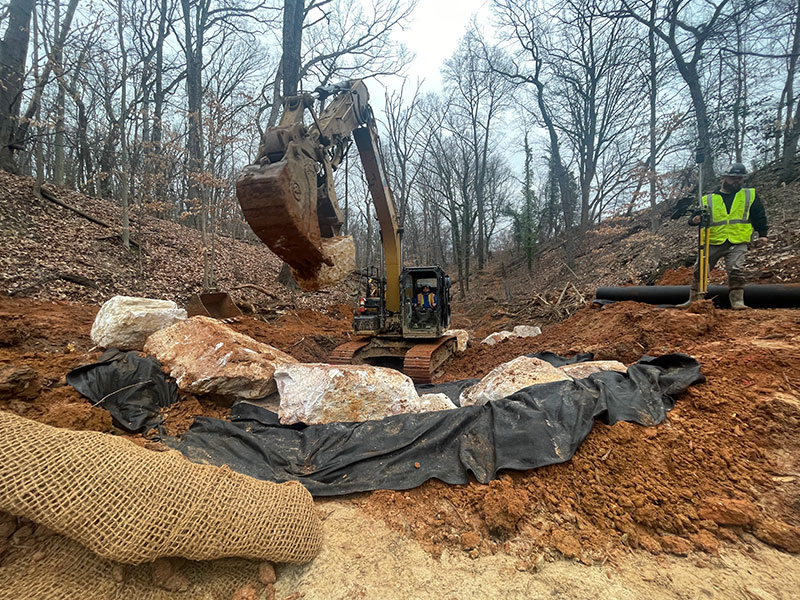
With design-build team members MLS and Ecological Restoration and Management (ER&M), Biohabitats is helping the DOEE restore two damaged stormwater outfall gullies that ultimately connect with different tributaries of the Anacostia River. Located in a steeply sloped, forested area of the park, the surrounding neighborhoods were developed long before the existence of modern stormwater management, resulting in concentrated storm flows from the paved surfaces discharging to the top of the slopes. This caused the flow paths through the wood to enlarge from stream bed and bank erosion and develop into degraded gullies, draining wetlands and transporting trash and pollutants into the Anacostia River.
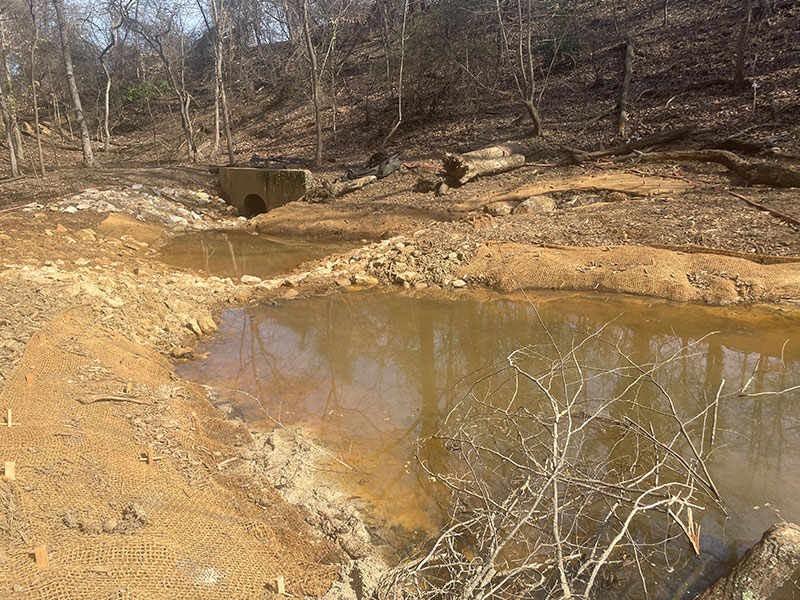
An older pipe in one of the gullies extends under the neighborhood and hides a network of buried streams — creating the rare opportunity for our team to restore a portion of a headwater stream that, for most of its length, has been piped and hidden beneath the ground.
After the team finalized the design and procured all necessary permits, construction began in January, with the goal to finish in early June. An RSC approach is being used for both gullies. Designs feature a series of large, steep boulder cascades and shallow pools to stabilize the system. Despite limited construction access due to terrain, highly erosive soil on the steep site, and the challenge of minimizing impacts to the surrounding trees, finding design solutions tailored to the unique project site, and making adaptive management adjustments during construction to maximize the project outcomes has been a smooth process. It’s a great advantage to work with a client who values the benefits of design-build.
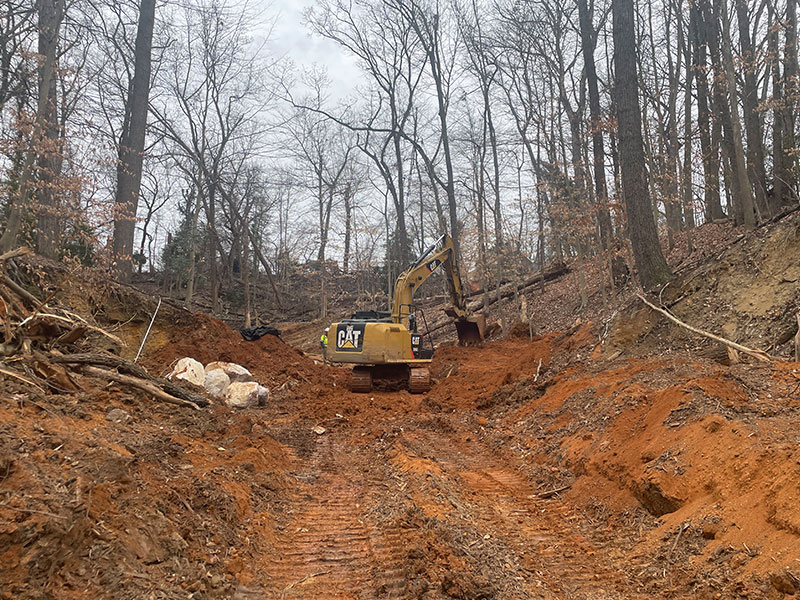
This restoration will help advance the DOEE’s efforts to reduce flooding and erosion in the city’s residential areas through updated and sustainable stormwater management controls. Combined, the two gully restorations will add stability and function to 1,300 feet of stream. For questions about this project, please contact Doug Streaker.
Let’s Jam!
It has been a warm and muddy winter in Ohio’s Greenbriar Valley, but our construction partners adapted, and we have completed a design-build project! In December 2023, Biohabitats, Cuyahoga Soil & Water Conservation District and MLS installed woody debris jams, large log jams, and riffles to raise the incised stream channels to facilitate floodplain connectivity, reduce erosion, and restore aquatic and terrestrial habitat. In 2024, The project team relocated 700 LF of stream, reactivated nearly 1,000 LF of abandoned floodplain channels, created new wetland pools, stabilized streambanks using native vegetation and riparian plantings, installed grade control structures, and treated invasive species in 3 acres of wetland.
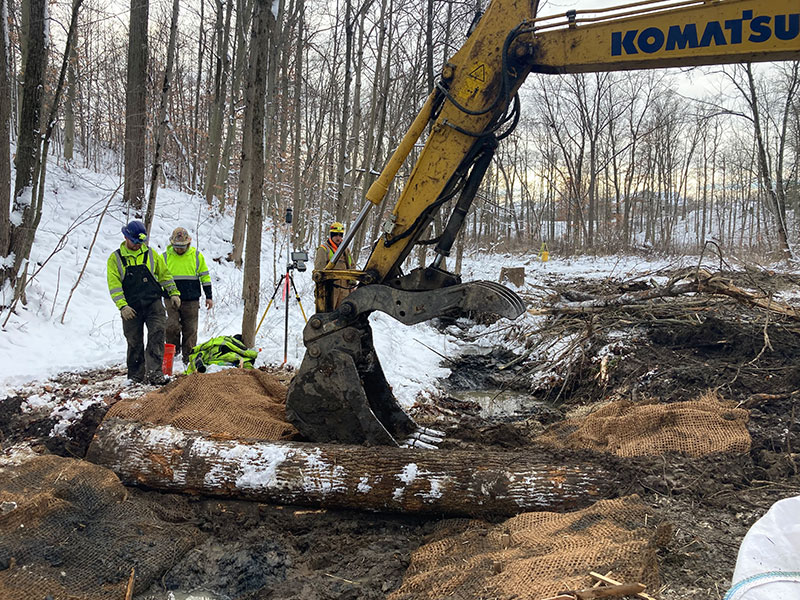
Adding log jams to the stream network reconnected and reactivated the wetlands and floodplain, spreading out and reducing velocities in this anabranching stream system and improving the water quality entering the East Branch Rocky River. Restoring the valley with this technique rehydrates the wetlands and removes an actively eroding channel from the toe of the valley slope, protecting residential areas above.
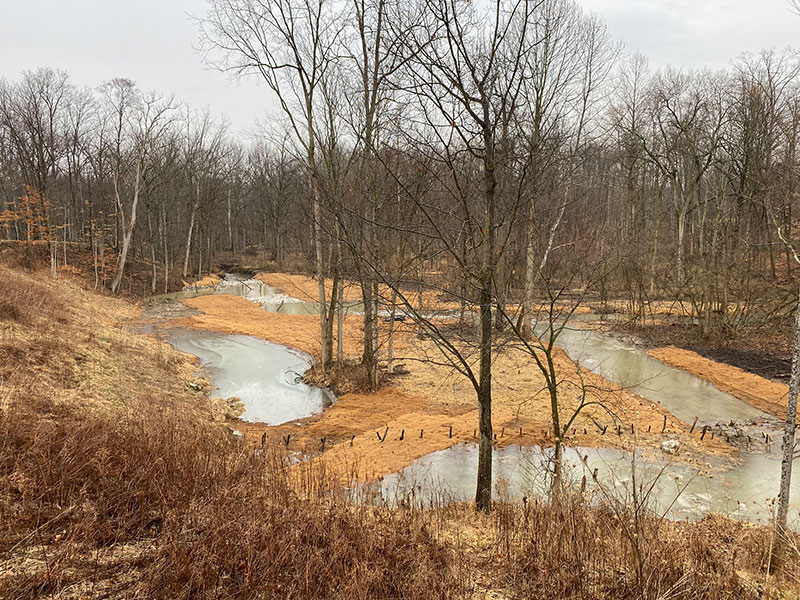
Thanks to our collaboration with Cuyahoga Soil & Water Conservation District, Northeast Ohio Regional Sewer District, MLS, Chagrin Valley Engineering, ASC Group, Inc., and Crowley’s Vegetation Control, this project restored the stream to a self-sustaining system that can flourish with minimal human intervention. We can’t wait to see this site teeming with life in a few months! If you have any questions about this project on the East Branch of the Rocky River, please contact Rachel Spadafore.
Biofiltration Brings Life to a Landmark in our Nation’s Capital
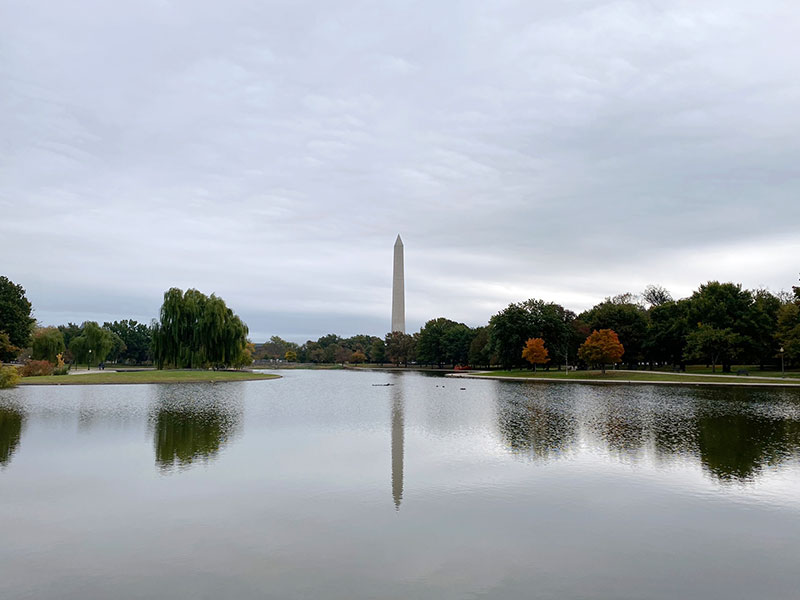
Coming soon: Constitution Gardens in Washington, D.C., is getting an ecological and aesthetic rehabilitation! As part of the PWP Landscape Architecture team selected by Trust for the National Mall, Biohabitats is designing the biofiltration wetland system for the Gardens’ lake. This system will provide deeper lake depths to enhance habitat and is one of the largest of its kind in Washington, D.C., restoring the function once provided by riparian wetlands and ultimately filtering 11,000,000 gallons of annual stormwater runoff. Constitution Gardens remains an integral part of a busy tourist area that is vulnerable to higher intensity flooding events from the Potomac, underscoring the need for a robust, resilient biofiltration system. The system will improve water quality and restore living, functional ecology to a dynamic landscape for the benefit of people and nature. Originally dedicated in 1976 to commemorate the U.S. Bicentennial, the goal is for the garden to be ready for the 250th anniversary of the signing of the Declaration of Independence in 2026. Check out this video for more details, and keep an eye on this space for updates! For questions about this project, please contact Jim Cooper.
Award-Winning Projects
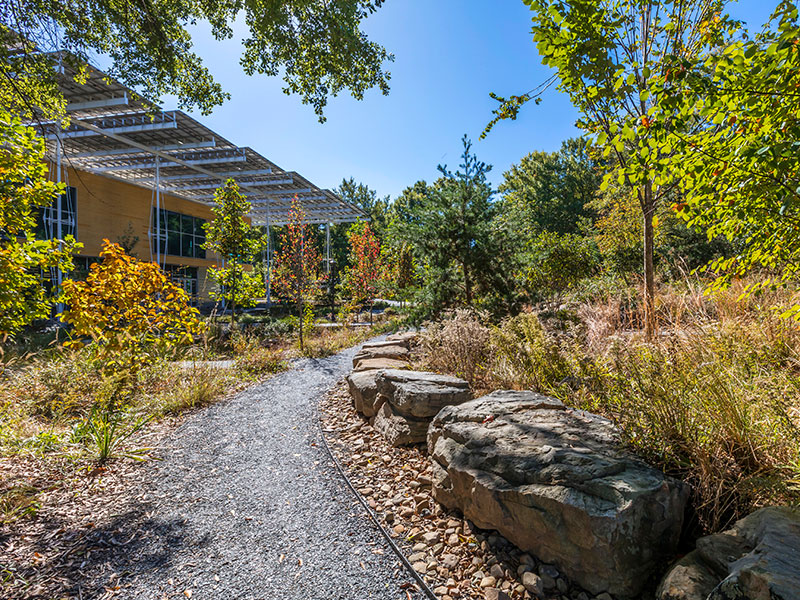
We’re thrilled to share that the Georgia Tech EcoCommons received the 2023 Presidential Award of Excellence from ASLA Virginia! This 8-acre living laboratory pays tribute to the ecology of Georgia’s piedmont region while also commemorating an important site in Civil Rights history. As part of the design team led by Nelson Byrd Woltz and Barge Design Solutions, Biohabitats developed a concept that would mimic the site’s historic landforms and native piedmont plant communities and provide a mosaic of native habitats and refuge within an urban ecological context.
Rose Villa Senior Living, a retirement community with a mission to help older adults live the life of their own choosing, received the Design for Aging Review, Special Recognition Award from The American Institute of Architects! Rose Villa kept the winning streak going when it also received First Place in Senior Housing News’ Architecture & Design Awards in the Continuing Care Retirement Community/Life Plan category! During their three-phase development project, Rose Villa sought to incorporate sustainable water infrastructure to treat a portion of its greywater and reuse it for toilet flushing and irrigation, enhancing campus self-sufficiency. As part of an integrated design team led by Scott Edwards Architecture, Biohabitats provided design, engineering, permitting, and construction oversight services to develop a district-scale greywater treatment and reuse system for this beautiful garden campus. Congratulations to the project team!
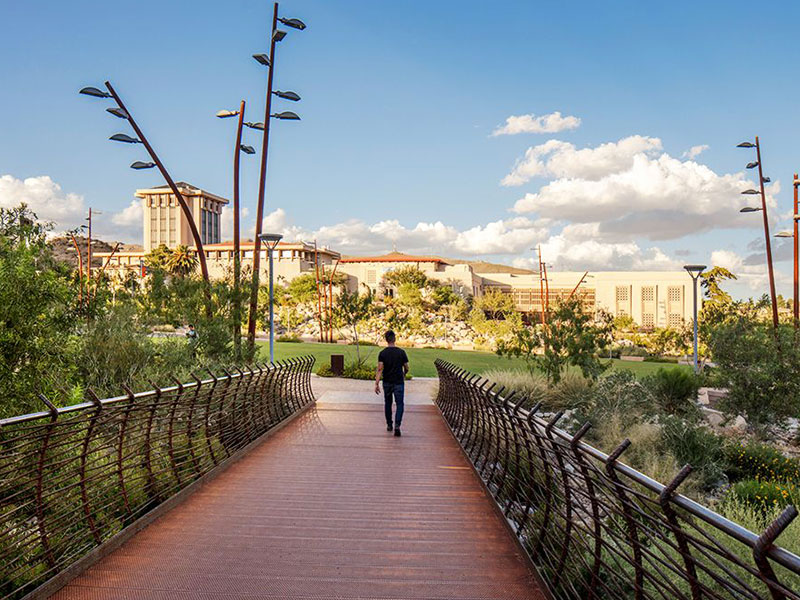
Before its transformation, the University of Texas at El Paso campus was dominated by asphalt, and much better for cars than it was for people. After UTEP’s Campus Transformation Plan, it became an accessible network of pedestrian-friendly walkways and biodiverse green spaces, and the American Society of Landscape Architects took notice! The University’s authentic, connected landscape won the 2023 ASLA Professional Award’s Honor Award for General Design. Biohabitats was a key member of the Ten Eyck Landscape Architects team on the planning and design for Centennial Plaza, a large open area at the heart of the campus. Biohabitats crafted a design for low impact stormwater management that infiltrates and conveys stormwater runoff for use in irrigation, allowing native Chihuahuan Desert vegetation to flourish on campus and creating a key amenity for the community. Congratulations to Ten Eyck Landscape Architects and our collaborators Lake Flato!
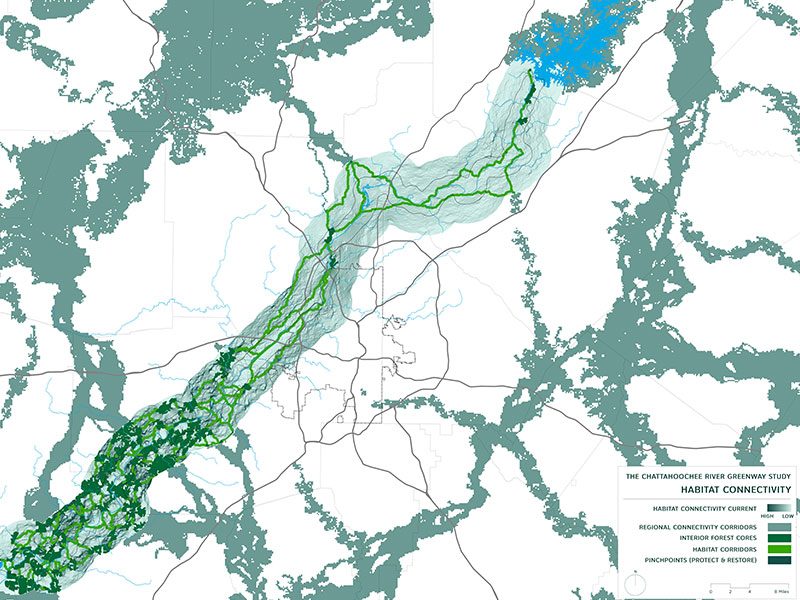
The Chattahoochee RiverLands study, commissioned by the , received a 2023 ASLA Professional Awards Honor Award for Analysis and Planning. The study produced a carefully designed greenway corridor that considers a variety of cultural, ecological, and infrastructure concerns while connecting people to the iconic river that defines and serves the region. As ecological design and planning consultants on the team led by SCAPE Landscape Architecture, Biohabitats led the ecological assessment of the study area and participated in public outreach events.
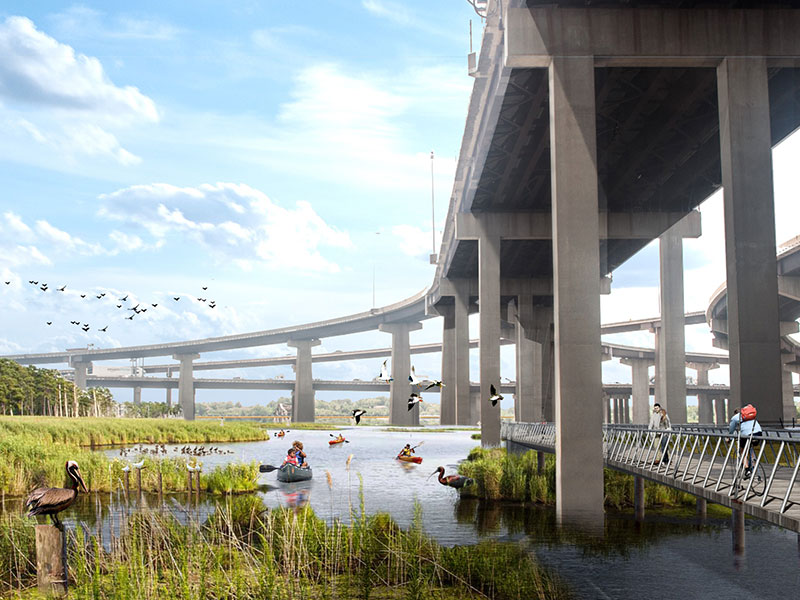
Wait, don’t scroll away yet! We have one more recognition from the 2023 ASLA Professional Awards to share! The transformative Reimagine Middle Branch master plan promotes community health, climate resilience, and biodiversity by improving access and connectivity to 598 acres of parkland and restoring Chesapeake Bay habitats. Biohabitats is leading the design of nature-based solutions for this effort, which include tidal marshes and creeks, habitat structures, and critical area buffer restoration. Congratulations to South Baltimore Gateway Partnership, Field Operations, GreenVest, Moffat & Nichol, and the entire project team on receiving an Honor Award in Analysis and Planning from ASLA!
Places
Keep SC Wild
The South Carolina Environmental Law Project (SCELP) does amazing work to protect South Carolina’s biodiversity, address climate change impacts, and right environmental injustices.
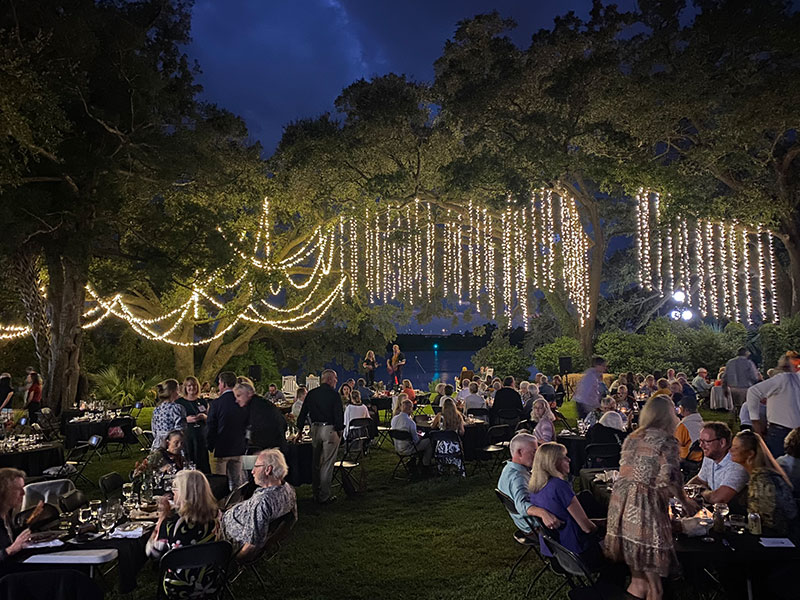
Biohabitats was thrilled to sponsor SCELP’s 14th Annual Wild Side fundraiser last October, and we were just as excited to attend. ACLU of South Carolina‘s Michelle Mapp was a wonderful, featured speaker, and it was a beautiful night to enjoy music by the waterfront. Cheers to our lawyers for the wild side!
SER Mid-Atlantic Chapter Conference
Thank you to everyone who attended the Society For Ecological Restoration (SER) Mid-Atlantic Chapter Conference to learn about and experience the Teaneck Creek Park Wetland Restoration project!
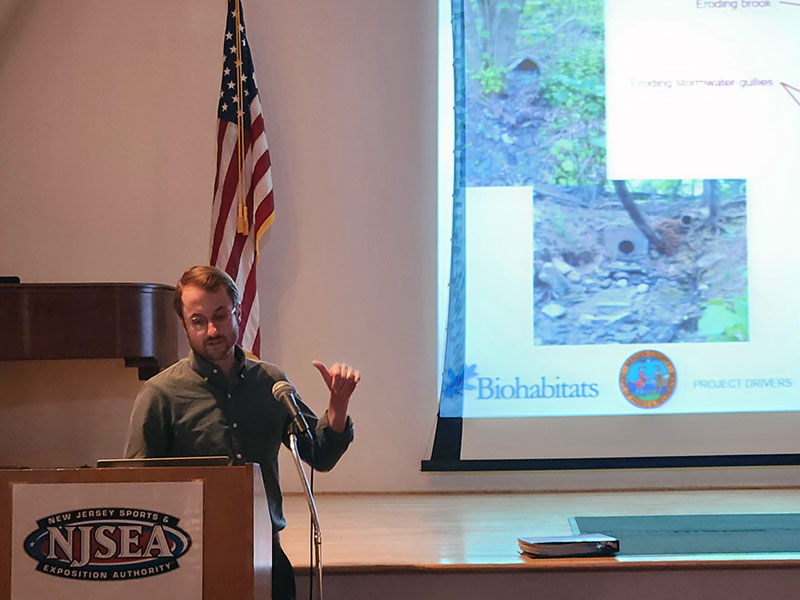
We appreciate every chance we have to share this beautiful open space and stroll through the park with our colleagues and the Teaneck community, including project partners NJSEA and Bergen County Parks System.
Mega-Eco Project Symposium
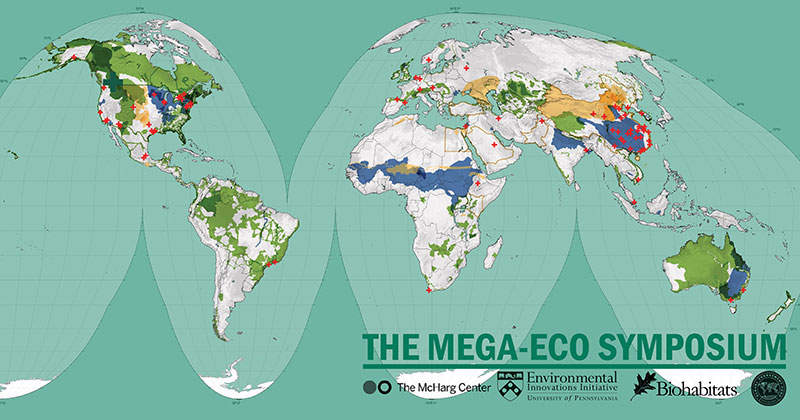
Held over the course of two days, MEGA-ECO: A Symposium on Very Large-Scale Landscape Projects presented by the Ian L. McHarg Center for Urbanism and Ecology and Penn Global, brought together representatives from major ecological restoration projects in China, Pakistan, Brazil, Africa, Korea, Canada, and the USA to explore cross-border approaches to conserving and restoring biodiversity. Check out the symposium playlist for panels on continental connectivity, anti-desertification, restoring watersheds, metropolitan development, and more. a robust discussion with a collection of seasoned professionals, including Biohabitats’ founder Keith Bowers, following the 4th panel on building ecological resilience in metropolitan areas. Biohabitats was a proud sponsor of this inspirational symposium.
Industry Summit on Nature-based Solutions
There is more to be done to advance and apply the use of nature-based solutions, but the organizations who attended the Industry Summit on Nature-based Solutions are ready to do the work! Thank you to the University of Georgia’s Institute for Resilient Infrastructure Systems for hosting an event that captured the spirit of collaboration that is necessary to meet the challenges of our climate crisis.
Nature-Based Exchange Compendium Celebration
Last November, Biohabitats joined The Nature Conservancy for the Nature-Based Exchange Compendium Celebration. Attendees enjoyed appetizers, networking, and ecologically focused vendors at the Clemson Design Center while celebrating the release of the full Compendium, a collection of notes and takeaways from the Nature-Based Exchange workshop series. Biohabitats was a proud sponsor, organizer, and contributor to the workshops. See upcoming events below to discover what’s next for the Nature-Based Exchange.
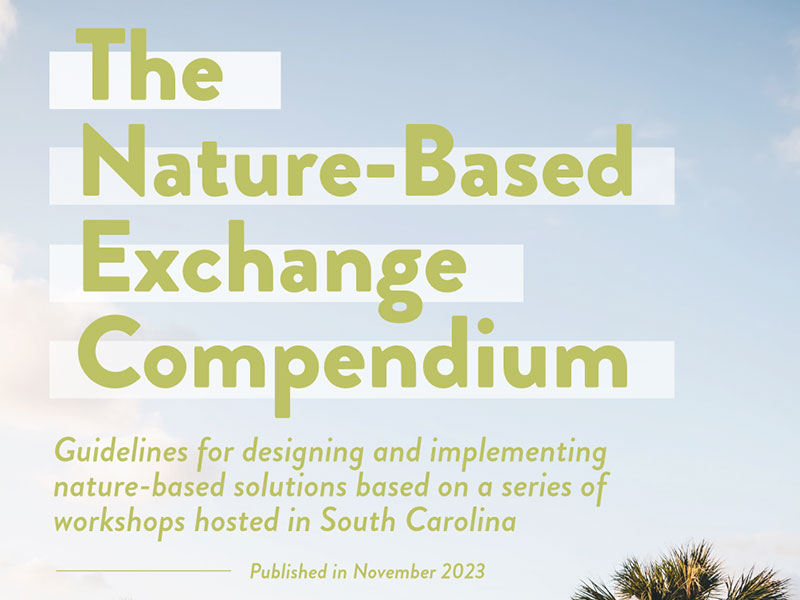
ASLA 2023 Conference on Landscape Architecture
Ecology was in the spotlight as Biohabitats accepted the Landscape Architecture Firm Award at the American Society of Landscape Architecture’s 2023 conference. This is an amazing acknowledgment that design firms have the power to address climate change, biodiversity loss, and environmental justice in their work. We were honored to receive this recognition among the many inspiring ASLA Honors Award recipients. We look forward to working together to restore the future!
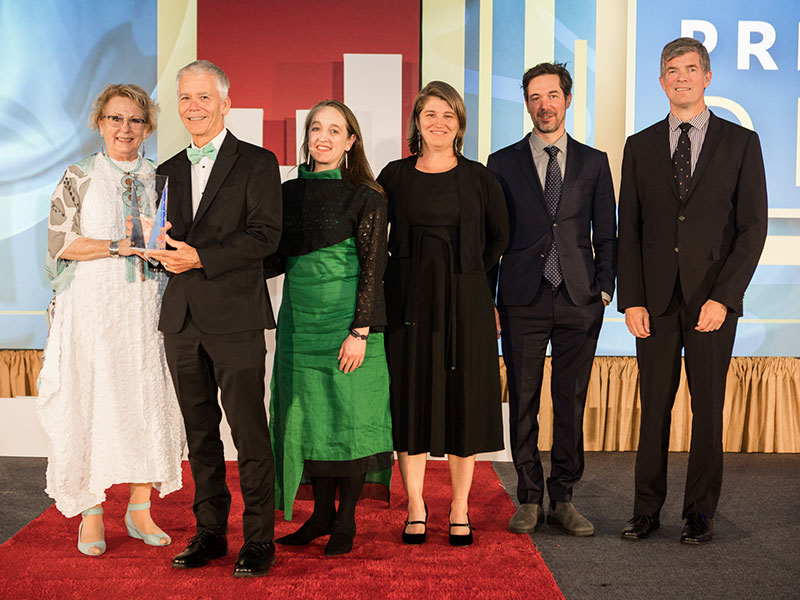
Thanks to all who attended talks on our ASLA Award-winning projects: Chattahoochee RiverLands with SCAPE; Reimagine Middle Branch with ; and the University of Texas at El Paso campus transformation with Ten Eyck Landscape Architects. There was much to see and do at ASLA 2023, but between awards ceremonies and presentations, we always make time for a family dinner. Our team members may be from different bioregions, but they’re united in Biohabitats’ mission, and in their love of good food and company. See you in D.C. at ASLA 2024!
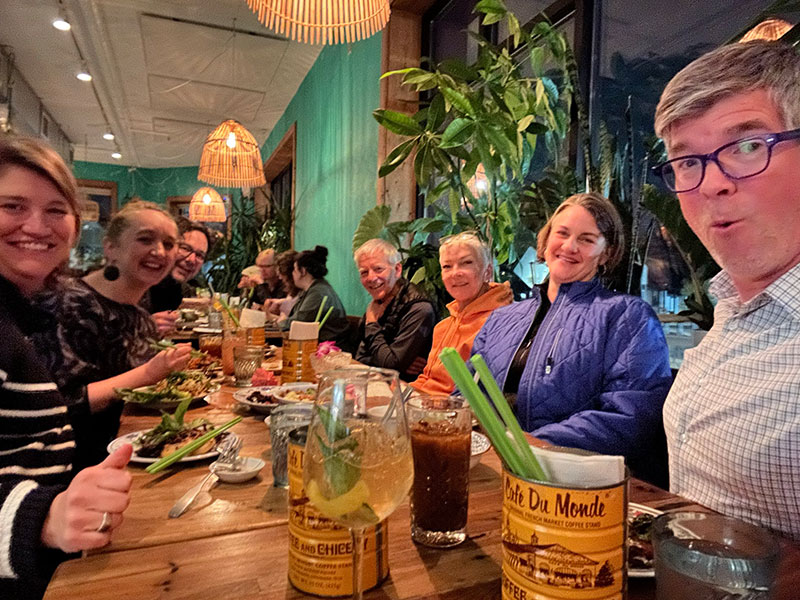
Martin Luther King Jr. Convocation Keynote Address
“If you want to change the world, I encourage you to read, study, share what you’ve learned, and let the words on the pages of your books into your heart and let your heart guide your hands to make positive choices that will impact generations beyond your own.” – Tanaira Cullens
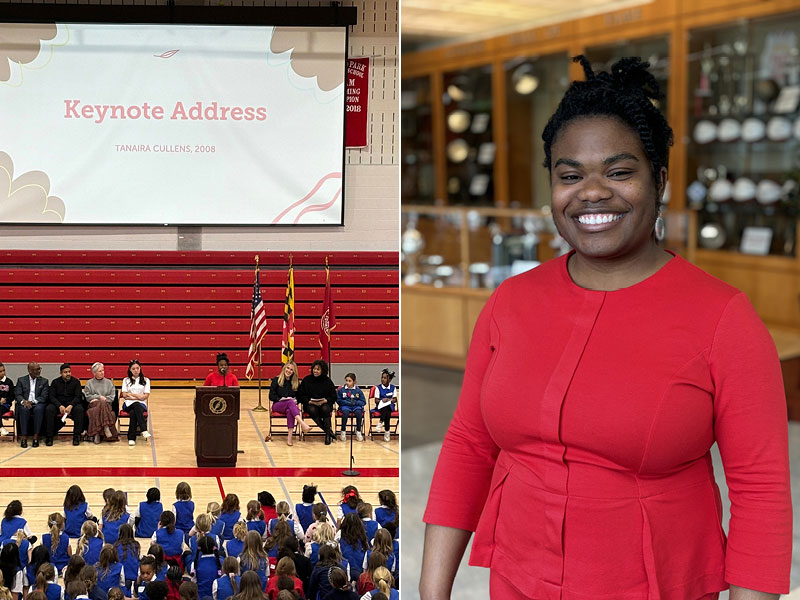
This past January, Biohabitats’ Environmental Scientist Tanaira Cullens returned to her high school alma mater to deliver the keynote address during an all-school Dr. Martin Luther King Jr. Convocation focused on the theme “Living the Dream: It Starts With Me – Spreading Hope, Courage, and Unity.” She spoke about the power of words and shared ways to make a positive difference in the world.
The Ekdahl Lecture Series
Hosted by the College of Architecture, Planning & Design at Kansas State University, the Ekdahl Lecture Series features speakers who have made significant contributions to the fields of architecture, landscape architecture, and industrial design. This year’s series was kicked off by Biohabitats’ founder Keith Bowers with an inaugural lecture on the intersection of biodiversity conservation, climate adaptation, and environmental justice. Missed it? Don’t worry, check out the recording from KSU!
Delaware Wetlands Conference
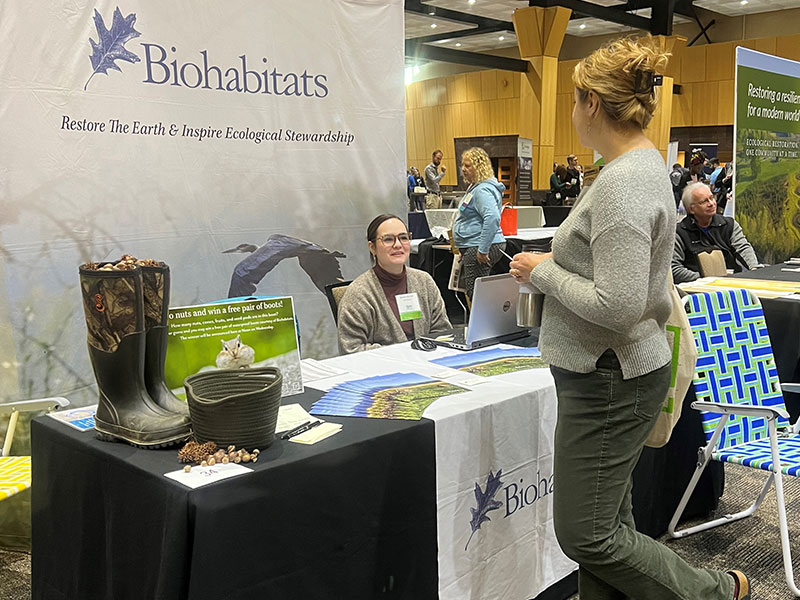
The 2024 Delaware Wetlands Conference was a blast! We hope attendees enjoyed Senior Ecologist and Practice Leader Joe Berg’s plenary talk, and his presentation on the Lizard Hill Sand Mine Reclamation. Thank you to everyone who stopped by the Biohabitats booth to say hi to Senior Environmental Scientist Sarah Roberts and Marketing Coordinator Brooke Marshall and enter our nutty contest. Visitors guessed how many nuts, cones, fruits, and seed pods we stashed inside a pair of boots for a chance to win a brand-new pair of muck boots. The winning guess was 237….and the grand total was 248! A powerful testament to the estimating power and knowledge of conference attendees.
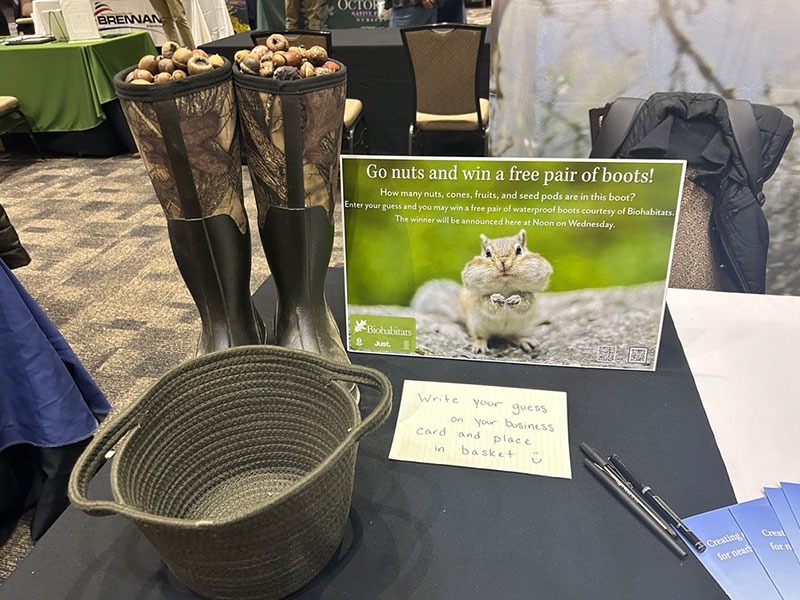
Upcoming Presentations and Events
April 5-7: Biohabitats will present our work on the Sandusky Bay Restoration Initiative this April at the 2024 Ecological Society of America Great Lakes Regional Conference (ESA), the first regional ESA event in the Great Lakes and Midwest!
April 10-11: If you have your tickets for the U.S. EPA Onsite Water Reuse Summit in Washington, D.C., don’t miss the Deploying Onsite Treatment Systems and Lessons Learned session on day two! Biohabitats’ Erin English will be sharing her perspective on onsite water reuse for high performance buildings as part of a panel of designers and operators.
April 10-11: The 34th Annual Nonpoint Source (NPS) Conference aims to unite municipal government staff, nonprofit organizations, private sector professionals, and academia to address NPS pollution issues and projects. This year, Kevin Dahms will present Biohabitats’ efforts on the Mill River Trail Green Infrastructure Corridor alongside panelists Nicole Davis from Save the Sound, Stephen White from the Town of Hamden, CT, and Ron Walters from the South Central Regional Water Authority.
April 24-25: During a critical turning point in the climate crisis, the theme of this year’s Texas ASLA Conference calls on landscape architects to “PIVOT” towards sustainable solutions. On 4/25, Biohabitats’ Aiman Duckworth will highlight our collaboration with the City of Austin on the Climate Vulnerability Analysis and Land Management Plan during the panel ASLA CAP in Action: Firms, Manufacturers and Advocates Respond to the Call. His presentation will center on planning, design, and management strategies to address climate change’s impacts on biodiversity. Aiman will join Sarah Fitzgerald from SWA Group, who will discuss firm climate action plans, and Amy Syverson-Shaffer from Landscape Forms who will present how manufacturing partners are taking climate action.
April 25: Registration opens March 25th for a one-day training session with the Nature-Based Exchange that will enhance practitioners’ understanding of native plants, soils, and habitat features in nature-based design. Led by Keith Bowers from Biohabitats, Erin Stevens from Surculus, and Joshua Robinson from Robinson Design Engineers, this session will explore best practices and equip participants with the tools needed to succeed at their own nature-based projects.
May 2: Join us at the Baltimore Museum of Industry and raise a glass to your love for the Chesapeake Bay at the 26th annual Treasure the Chesapeake Celebration! Biohabitats is honored to be a sponsor and excited to catch up with friends old and new on the Baltimore waterfront.
May 5-8: Dive into insightful discussions on comprehensive stormwater and watershed management and updates on environmental issues, technologies, regulations, and pollution prevention strategies at the 2024 Ohio Stormwater Conference! This year is overflowing with opportunities to connect and learn with Biohabitats. Don’t miss our booth and sessions led by the Biohabitats team: Learn about the East Branch Chagrin River Restoration with Kevin Grieser, Brett Long, and project partners Brewster Shefelton from Chagrin River Watershed Partners and Steve Fabian from Meadville Land Service; check out Erin Mundorf’s discussion on the role that both humans and beavers have in the long-term success of restoration projects; and join Suzanne Hoehne for a talk about weather and its impacts on estuarine restoration in the Great Lakes.
May 7-9: The 2024 International Living Future Conference is almost here! Join us in Atlanta to explore sustainable and regenerative spaces with the people who designed, built, and now manage them. Don’t miss the open house, presentations, and panel discussion at Georgia Tech’s Kendeda Building for Innovative Sustainable Design. On day two, attend talks by Erin English from Biohabitats, Joshua Gassman from Lord Aeck Sargent, and Marc Brune from PAE on achieving LBC in the Southeast, or join Pete Munoz from Biohabitats for tips on starting LBC projects.
July 30-Aug. 1: Cultivate connections and explore in-depth sessions at the ASLA Florida Annual Conference and Expo in Orlando. This year’s event, which will focus on nurturing cultural landscapes, embracing policy engagement, and strengthening climate resilience, will kick off with a keynote address delivered by Biohabitats’ Keith Bowers.
People
Meet our newest team members!

Please join us in welcoming Emily Beacham, Joey Marshall, and Nolan Schillerstrom to the Biohabitats team! Can you guess which new team member built a pond in their urban backyard? Who is the photographer that loves R&B and can recite a weird number of pi digits? How about who used to play the guitar for jazz groups in the Midwest? Does it just so happen that two of our new hires enjoy a good scuba dive? Find the answers on the Rhizome blog.
Introducing a new leadership team for Biohabitats
Our transition in 2023 to a Perpetual Purpose Trust ownership model was a natural turn in our evolution. It was a turn away from an extractive business model focused on satisfying individual shareholders, and towards a sustainable, regenerative way of practicing and growing our business. Earlier this year, we announced a transition in leadership, which rounded out that turn. Ted Brown, PE, is now Biohabitats’ President. A water resources engineer who joined Biohabitats in 2006 and who has led the firm’s business development efforts in recent years, Ted now guides a leadership team in stewarding the firm’s projects, operations, culture, financial health, innovation, growth, and marketing. Our founder and former President, Keith Bowers, has transitioned to the position of Practice Leader, a role which enables him to strengthen his involvement in the firm’s projects, deepen his mentorship of team members, and increase his advocacy in support of our mission.
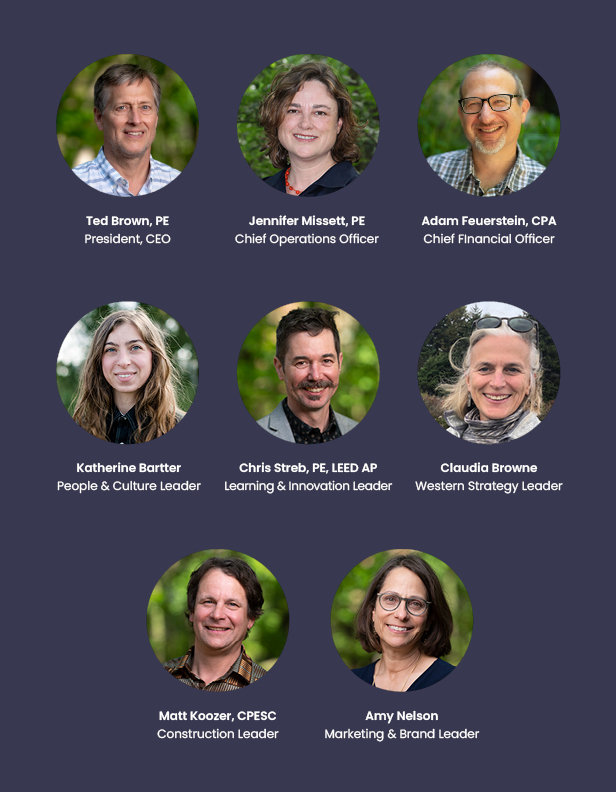
“As in nature, change is essential for growth and development, and this transition of leadership is a necessary part of Biohabitats’ evolution,” said Keith. “Ted is a natural leader, and I am confident in his ability to guide Biohabitats into a future in which the impact of our work and the reach of our mission will expand exponentially.”
“Keith is more than our founder and former President,” said Ted. “He is the heart and soul of Biohabitats, and he will remain very much involved in our work, operations, and in his new role as Practice Leader.”
Other members of Biohabitats’ leadership team include Adam Feuerstein, CPA, Chief Financial Officer; Jennifer Missett, PE, Chief Operations Officer; Chris Streb, PE, LEED AP, Learning & Innovation Leader; Katherine Bartter, People & Culture Leader; Matt Koozer, CPESC, Construction Leader; Claudia Browne, Western Strategy Leader, and Amy Nelson, Marketing & Brand Leader. For more about our leadership transition check out the Rhizome blog.
Elevating Excellence
Speaking of leaders… we are thrilled to share the news that Jennifer Dowdell has been promoted to the position of Practice Leader: Landscape Ecology, Planning & Design. In her 17 years with Biohabitats, Jennifer has applied her deep knowledge of landscape ecological principes to numerous site planning and design projects. This includes innovative master planning projects that are crafted around a foundation of ecology. Jennifer’s unique skillset, perspective, and devotion to Biohabitats’ mission elevates not only our planning practice but our spirits. We couldn’t be happier to share this news of her promotion.
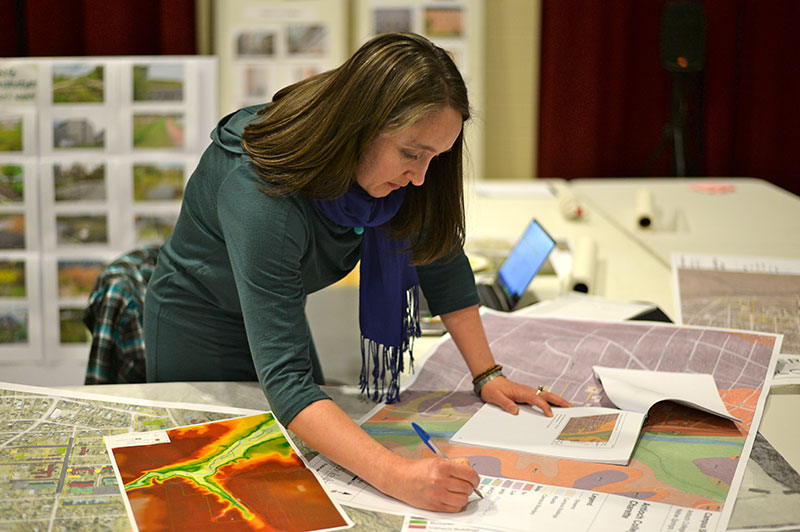
SER Restoration Fellows
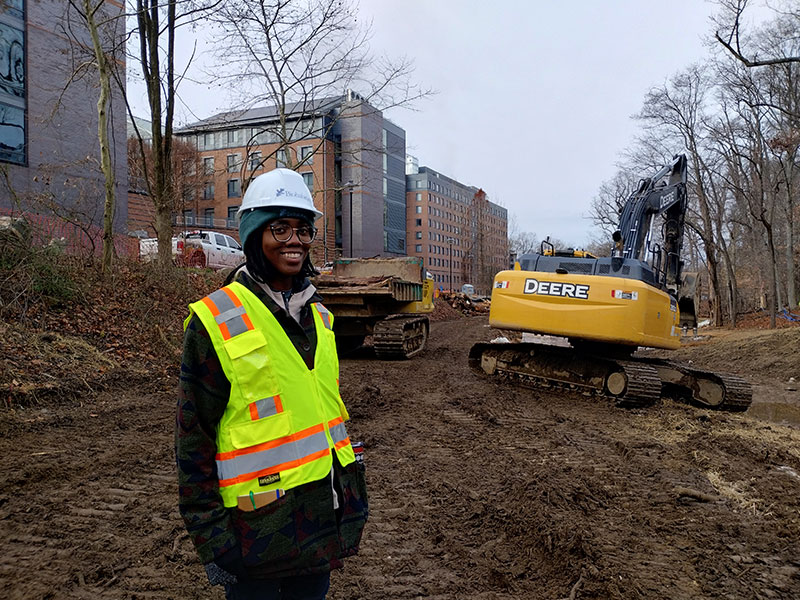
Society For Ecological Restoration (SER) Fellows LeeJi Drifwood and Mickki Garrity are already making an impact in the world of ecological restoration! Biohabitats is thrilled to support their journey as SER’s partner in this program, which offers fellowships for emerging restoration professionals from underrepresented communities in North America. The fellowship provides authentic career opportunities while advancing the next generation of visionary ecological stewards.
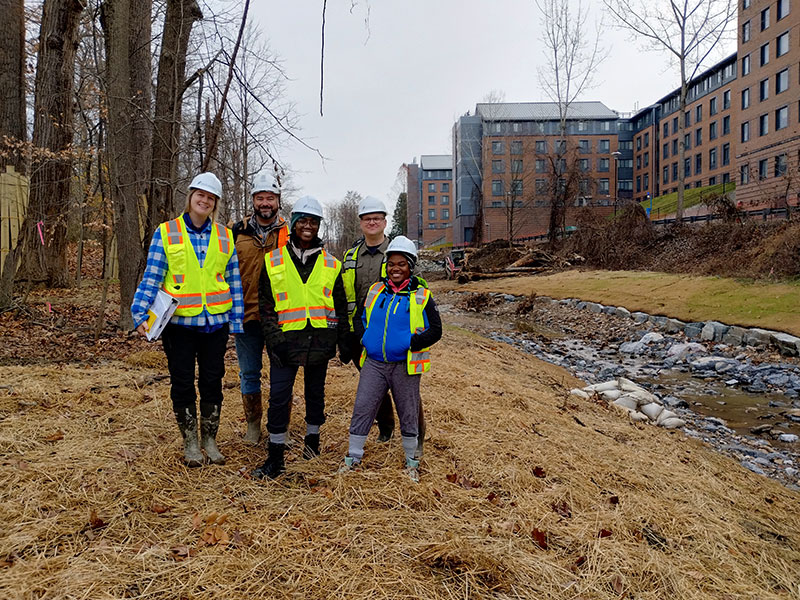
We loved having SER Fellow LeeJi Drifwood visit our Chesapeake/Delaware Bays Bioregion office and join us for a construction meeting at the site of the Towson Run Stream Restoration! We enjoyed meeting LeeJi, learning about their work with SER, and sharing our perspectives as restoration practitioners. Sponsoring SER’s Restoration Fellows program and supporting emerging professionals is a joy and an honor!
An Extraordinary Extern
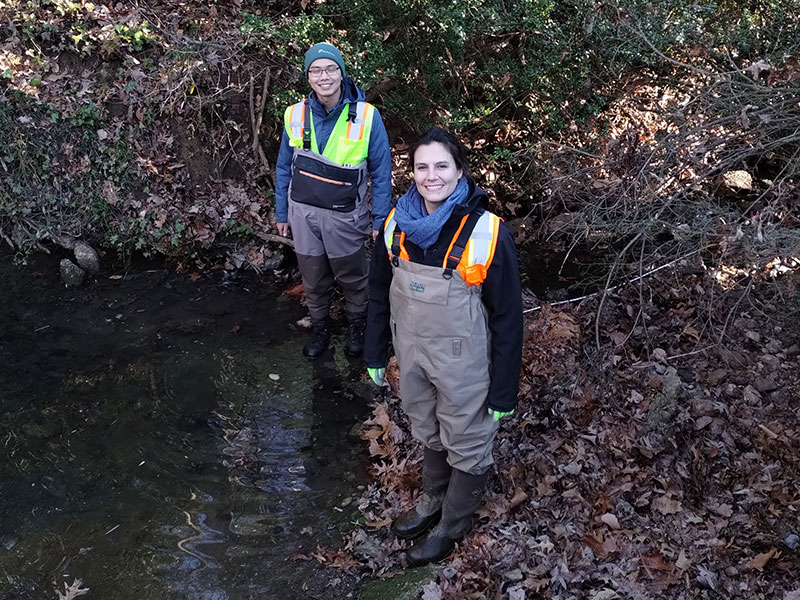
This January, Master of Landscape Architecture student Allyson Gibson participated in an externship program through the University of Virginia that brought her to Biohabitats for a week of professional experience. While shorter than a traditional internship, an externship can provide some quick insight into what it’s like to work in your chosen field. Learn more about Allyson’s time with Biohabitats on the Rhizome blog.
Award-Winning Team Members
Biohabitats’ quarterly Golden Acorn award is presented to a team member who has excelled in demonstrating our mission to “Restore the Earth and Inspire Ecological Stewardship.” The gold color symbolizes purity of purpose in protecting and defending nature, and the acorn symbolizes strength of resolve. Golden Acorn winners are awarded $1000 to donate to non-profit organizations of their choice. The most recent winners of the Golden Acorn award were Senior Water Resources Engineer Katie Talley, and Construction Coordinator Jim Favret, both from our Chesapeake & Delaware Bays Bioregion. Katie chose Invasive Species Action Network and The Giving Grove as the recipients of her Golden Acorn donation. Jim directed his donation to the Smithsonian Environmental Research Center and NorthBay Adventure. Congratulations to Katie and Jim!
